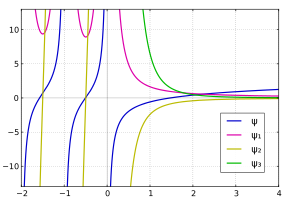This article relies largely or entirely on a single source. (August 2021) |


In mathematics, the polygamma function of order m is a meromorphic function on the complex numbers defined as the (m + 1)th derivative of the logarithm of the gamma function:
Thus
holds where ψ(z) is the digamma function and Γ(z) is the gamma function. They are holomorphic on . At all the nonpositive integers these polygamma functions have a pole of order m + 1. The function ψ(1)(z) is sometimes called the trigamma function.
 |
 |
 |
| ln Γ(z) | ψ(0)(z) | ψ(1)(z) |
 |
 |
 |
| ψ(2)(z) | ψ(3)(z) | ψ(4)(z) |



